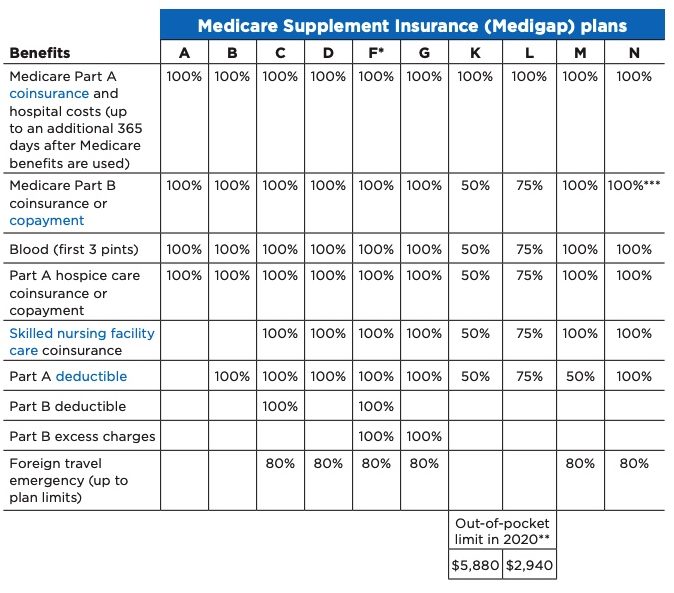Medigap (Medicare Supplements)

Medigap (Medicare Supplements):
A detailed break-down of what exactly is Medigap, also known as Medicare Supplements.
Medigap plans (also known as Medicare Supplements) are one of the two main Medicare coverage options. They are NOT Medicare Advantage plans. In fact, they are the opposite of Medicare Advantage Plans.
Original Medicare only covers 80% of your Health Coverage. There are only two ways to cover that 20% coverage gap:
THE TWO CHOICES:
1) Medicare Supplement (Medigap)
OR
2) Medicare Advantage Plan (Also known as Part C.)
If you decide to have a Medicare Supplement (Medigap):
your primary coverage is still Original Medicare (Parts A and B), and your Medigap plan becomes your secondary coverage.
As you educate yourself on Medicare, it is important to remember that with Medicare Supplements (Medigap), Original Medicare remains your primary coverage, they are in charge of taking your claim.
With Medicare as your Primary, and a Medicare Supplement (Medigap) Plan as your secondary, you have the freedom and flexibility to receive Medicare-approved care at ANY provider or hospital that accepts Medicare.
*93% of primary care doctors accept Medicare. (Kaiser Family Foundation (KFF))
If your hospital or doctor takes your Medicare Card, they must take your Medicare Supplement (Medigap) plan, regardless of the private insurance company that provides your coverage. Instead of asking, “do you accept ABC insurance company?” you can ask, “do you accept Original Medicare?”.
If they say “yes”, your Medicare Supplement Card is always accepted. Medicare will take your claim. Your Medicare Card is billed at 80%, and your Supplement (Medigap) Card is billed at 20%.

Original Medicare does not cover Prescription Drug Plans. When you choose a Medicare Supplement (Medigap) Plan, you typically select what is called a Part D: Prescription Drug Plan as well.
Costs of Medicare Supplement Plans (Medigap)
Medicare Supplements (Medigap) plans generally have higher fixed monthly premiums (compared to Medicare Advantage plans), but it depends on which standardized plan you choose.
Types of Medigap Plans
The Centers for Medicare and Medicaid Services (CMS) states that “Insurance companies can only sell you a “standardized” Medigap (Medicare Supplements) policy. Medigap policies must follow Federal and state laws. These laws protect you. The standardized Medigap policies that insurance companies offer must provide the same benefits. Generally, the only difference between Medicare Supplement (Medigap) is the monthly premium cost.
standardized plans = same benefits
Because Medicare Supplements (Medigap) plans are standardized, you will often hear Medigap (Medicare Supplements) plans referred to by a specific letter.
The three most popular plans are: Plan F, Plan G, and Plan N.
If you are enrolled into Medicare after 2020, Plan F is not an option for you.
Here is a chart from the official “Medicare & You Handbook” showing the benefits of the ten standardized Medigap (Medicare Supplements) plans currently offered to consumers:

Plan G:
- With a Plan G Supplemental Plan, you pay an annual deductible of $203. After that, you are 100% covered anywhere Medicare is accepted.
- There are no copays, no coinsurance, no excess charges, and there is no maximum out of pocket. You are 100% fully covered anywhere Medicare is accepted.
93% of primary care doctors accept Medicare. (Kaiser Family Foundation (KFF))
Plan N:
- With a Plan N Supplemental Play, you pay an annual deductible of $203. After that, you are 100% covered anywhere Medicare is accepted.
- To keep the premium payment lower, there are two small copays.
- There is a $20 copayment to see a doctor, and a $50 copayment at the ER, unless you are admitted to the hospital. If you are admitted, the $50 copayment is waived.
- Plan N does not cover excess charges. Excess charges are rare; you would see it at a specialty clinic, ex. The Mayo Clinic.
- An excess charge happens when you receive health care treatment from a provider who does not accept the Medicare-approved amount as full payment. In these cases, a provider can charge you up to 15% more than the Medicare-approved amount.
- Because of the small copays, Plan N Premiums are typically much lower than a Plan G Premium.
Medigap (Medicare Supplements) Open Enrollment
Your Open Enrollment Period begins the month you turn 65, IF you are taking your Part B at that time. If you are still working, and have Creditable Coverage, you do not have to take Part B at this time. Schedule a free Consultation with us to see when to enroll into Part B.
The Open Enrollment Period is not the same as the Annual Election Period -that occurs from October 15th – December 7th. Instead, your Open Enrollment period is directly related to your first time taking Medicare Part B.
The Centers for Medicare and Medicaid Services (CMS) states, “Your individual Medigap Open Enrollment Period begins the first day of the month that you a both 65 or older AND enrolled in Medicare part B.”
During your Open Enrollment, there are zero health questions asked. You can enroll into and Medicare Supplement Plan without any health underwriting.
In most cases, if you want to enroll in a Medicare Supplement plan after your one-time six-month open enrollment, you will have to go through medical underwriting (in the form of health questions). You may be denied the ability to purchase a Medicare Supplement plan outside of your open enrollment period if you have certain pre-existing conditions at the time of your new Medigap application. Every Medigap company has different health underwriting criteria, so give us a call, we specialize in underwriting.
Can you Change Your Medicare Supplement Plan At Any Time? Yes!
We help clients year-round switch from one Medicare Supplement (Medigap) plan to another. Many consumers are unaware that if you can pass underwriting, you can change your Medigap coverage 365 days of the year! This is one way we can save you money if your premium has a rate increase, but you’d like the same plan.
Pros of Medigap
Comprehensive Medical Coverage -The most popular Medigap plans (typically G, N, and F) leave very little out of pocket medical costs for consumers that choose to enroll in one of those plans. The Medicare chart above shows that Plan F covers all the out of pocket medical costs for Medicare-approved procedures. Likewise, Plan G will cover the same out of pocket medical costs after you have paid your annual year Part B deductible ($203 for 2021). For help determining what procedures Original Medicare covers, you can go HERE to Medicare.gov.
Medicare Nationwide Coverage – Medicare Supplement plans are not HMOs or PPO’s like Medicare Advantage plans and therefore do not require you to receive treatment at “in-network” providers for lower-cost treatment. Instead, Original Medicare remains your primary insurer. Because Medicare is primary, you can seek care at any facility or provider in the country that accepts Original Medicare. Make sure that if you call a doctor’s office to find out if they will take your Medigap plan, you ask, “do you accept Original Medicare?”
Peace of Mind – The most popular Medigap plans (plan F and G, N) offer 100% coverage with Medicare. (Plan N has small copays/ possibility of excess charge.)
In retirement, having a relatively fixed monthly premium for medical care can help with budgeting. You have no unexpected large costs to worry about.
Separate Drug Coverage Based on your needs, you may choose a Part D coverage that best fits your unique health. Additionally, during the Annual Election Period (AEP) from October 15th – December 7th you can change your Part D coverage without impacting your Medigap coverage every year.
With Medicare Advantage, on the other hand, your medical coverage and prescription coverage are administered by one insurance company in a “bundled all-in-one” plan.
Medigap plans tend to offer a more customized approach to choosing Medicare coverage.
Guaranteed Renewable // The official “choosing a Medigap policy” handbook summarizes this best, “any standardized Medigap policy is guaranteed renewable even if you have health problems. This means the insurance company can’t cancel your Medigap policy as long as you stay enrolled and pay the premium.”
Outside of your Medigap insurer declaring bankruptcy and going out of business, your Medigap coverage will continue with the same benefits for the duration of your time on Medicare if you continue to pay your monthly premium. We recommend that our clients pay their Medigap premiums with automatic EFT payments for this very reason.
Cons of Medigap
Higher Monthly Premiums -The comprehensive medical coverage with a Medigap plan, of course, comes with a higher monthly premium when compared to most Medicare Advantage Plans.
Few “Extra Benefits” – Some examples of the additional benefits not offered include routine dental/vision/hearing coverage, over the counter benefits, prescription coverage, and fitness memberships. One exception to this is that the more popular Medigap plans do include some coverage for foreign emergency care, which is not provided by Original Medicare. Lastly, additional dental/vision/hearing coverage can be purchased separately to compliment your Medigap coverage.
Rate Increases // Along with higher monthly premiums, Medigap monthly premiums also increase during the lifetime of your Medigap coverage. You can almost always expect your plans monthly premiums to increase by a few percentage points every year due to various factors. Medigap plans undergo rate increases depending on how your plan is “rated.” The three main types of Medigap premium “ratings” include:
- Attained Age rated
- Issue Age rated
- Community rated
Give us a call so we can help you find the different rating options available to you in your zip code.

